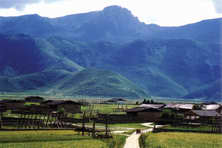| Searching for Shangri La |
| http://www.sina.com.cn 2003/05/20 12:56 中国周刊 |
◆Photo and text by Bruce Connolly
Shangri La is an idyllic and unpolluted paradise - a valley high in the mountains where nature and people live in harmony. A place where ageing takes a long time, a place of eternal youth. The 1937 film by Frank Capra starring Ronald Coleman and Jane Wyatt explored this idea. One famous quote by Jane Wyatt expressed there's a wish for Shangri La in everyone's heart - Oh, I just wish the whole world might come to this valley.? Hilton suggested that Shangri La could be located in a long valley with rounded hills on either side and capped by the loveliest mountain on earth. One theory is that Hilton's book was inspired by a series of 10 articles on North West Yunnan written by an Austro-American Dr Joseph Rock for the National Geographic Magazine between 1924 and 1935. He introduced exotic kingdoms, faraway people and little known snow-mantled peaks. His main work, published in 1947, was a large book called ?The Ancient Nakhi Kingdom of South West China? He lived on and off for 27 years in the village of Yuhu at the foot of Yulongxueshan (Jade Dragon Snow Mountain) - part of the southeast foot of Himalayas.
However, there is a lot to be said about it - this is an area where people can explore remote valleys and within their minds find their own Shangri La. Possibly even more plausible is the small town of Daju north of Lijiang. It sits in a really isolated valley on the edge of Himalayas. There the Yangtze comes down from Tibet. An awe-inspiring location and until recently so cut off by the mountains that it was easy to believe the outside modern world did not exist!At the end of the Millennium I returned to Dali in Yunnan - my own Shangri La? I wanted to watch 1999 pass into 2000 in a place which I feel is heaven-on-Earth? Although long past my youth, walking every day in the valleys of snow-capped Cangshan Mountain or strolling in the sunshine along the shores of the great Erhai Lake I felt young. In that mountainous heaven, the home of colourful Bai people, the outside world seemed so far away. I did not want to return to it. A series of future articles will take us through the attractions and delights of Yunnan, the land beyond the Clouds Shangri La? Maybe! |
| 【英语学习论坛】【评论】【大 中 小】【打印】【关闭】 |

 In 1933 the writer James Hilton published a novel called lost Horizon. At its centre lies the notion that hidden beyond the Himalayan Mountains is a valley inhabited by people who have achieved an ideal human existence - Hilton called his valley Shangri La?
In 1933 the writer James Hilton published a novel called lost Horizon. At its centre lies the notion that hidden beyond the Himalayan Mountains is a valley inhabited by people who have achieved an ideal human existence - Hilton called his valley Shangri La? Although Shangri La was mythical concept some present-day researchers conveniently point to North West Yunnan. It is a magical serene setting where people can at least to a degree find Shangri La in their hearts.This is not a claim that it is Shangri La but it is a concept to hang the present tourist developments around. This area, as transport links, air, road and rail are improved, is attracting more and more tourists. Hotels and restaurants incorporate the name Shangri La?and the new airport on the Zhongdian plateau close to Tibet has adopted the name.
Although Shangri La was mythical concept some present-day researchers conveniently point to North West Yunnan. It is a magical serene setting where people can at least to a degree find Shangri La in their hearts.This is not a claim that it is Shangri La but it is a concept to hang the present tourist developments around. This area, as transport links, air, road and rail are improved, is attracting more and more tourists. Hotels and restaurants incorporate the name Shangri La?and the new airport on the Zhongdian plateau close to Tibet has adopted the name.